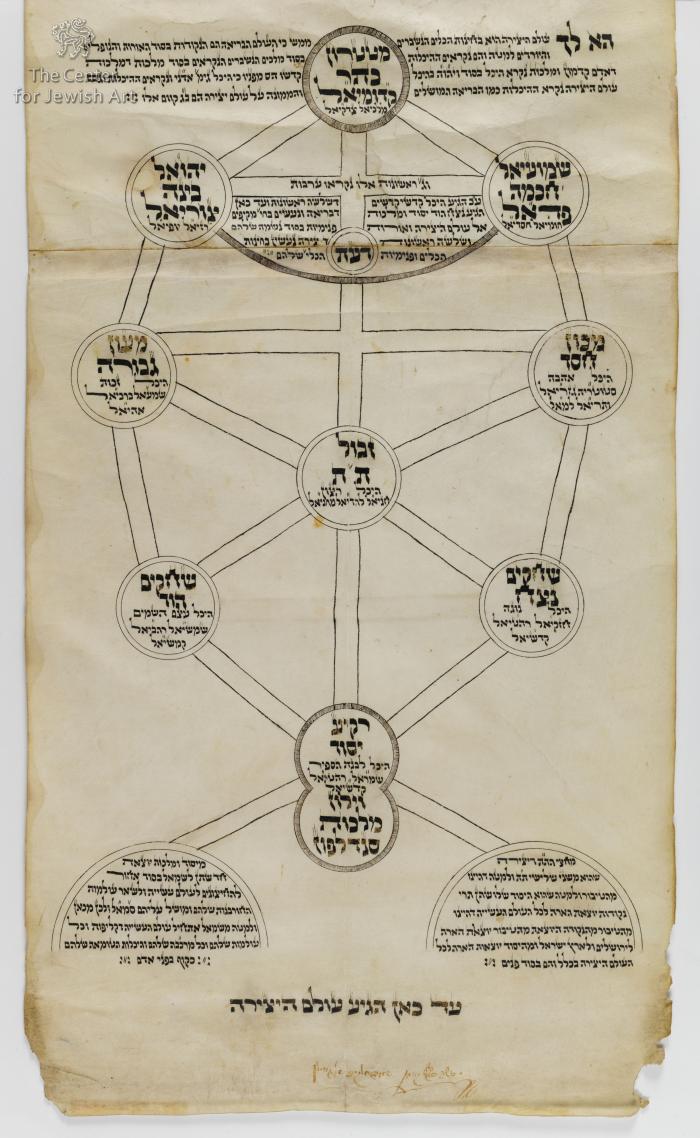Obj. ID: 45435 Great Tree, Germany, circa 1700

sub-set tree:
The following description was prepared by William Gross:
Kabbalistic diagrams resembling Porphyrian trees have been known at least since the sixteenth century as “Ilanot” [Heb. pl. Arborae; sing. "Ilan"]. [First such reference known to me is in the work of Guillaume Postel, who refers to "Ilanoth" as a genre of rabbinic literature.] Ilanot constitute visual representations of kabbalistic cosmologies from the relatively simpler forms of the thirteenth century to the far more complex and ramified systems in Lurianic Kabbalah from the sixteenth century onward. The increasing complexity of cosmic trees between the thirteenth and eighteenth centuries directly reflects the exponential ramification of kabbalistic theosophy that took place over those centuries. Given the overwhelmingly visio-spacial conceptions of the divine in its evolutionary “becoming” in these mystical traditions, Ilanot could serve as cosmic maps. This divine cartography aspired to capture the syncronic interrelations between the various facets of the godhead and creation as well as their diachronic, evolving emergence.
What’s an Ilan? Any synoptic diagrammatic presentation of kabbalistic cosmology. The basic graphical forms could range from the arboreal to the boldly anthropomorphic. Lurianic Ilanot, in their lengthy and complex presentations, often feature both, as well as spreadsheet-like tables. The iconic decadal tree is an Ilan, as is the intricately Baroque Hammerschlag Ilan. Diagrams expressing particular concepts within a larger framework, such as the illustrations that frequently accompany certain cosmogonic discussions in the Lurianic corpus, would doubtfully have been called ilanot by anyone. However simple or complex the pictorial-diagrammatic features of an Ilan, extensive textual material is frequently embedded in and around the geometrical forms. The texts may be paraphrastic chapter headings, original compositions, or the study notes of a student. Their connection to the pictorial features alongside which they appear is usually clear, with the text providing a verbal key to the quality or process depicted graphically. That said, in complex Ilanot, simple keying gives way to more complex and even inscrutable connections. Indeed, these manuscripts demand to be treated as “integrated systems of communication” that raise “questions about how verbal and visual patterns of meaning were constructed, combined, and modified.”
In earlier times the serious scholars of kabbalah would prepare a visual guide to the school of Kabbalistic thought which they studied. This was done on a long scroll called the Ilan Aroch. This is an example of such a scroll, using the rabbinic script of a Sofer Stam. These scrolls contain both text and illustrations, mostly concerning the Sephirot. Such scrolls are relatively rare, their number being estimated at less than 150 recorded in collections both public and private. The use of this Kabbalistic scroll became amuletic toward the end of the 19th century as there were fewer and fewer serious kabbalists. There exist many such small scrolls done in the same pattern and usually rolled into a closed silver tube to be worn as an amulet. This large scroll was written by a "Sofer Stam" on cow skin on seven sections sewn together.
Scroll # 1 - 13 frames (028.012.010) 1850ca ? Europe parchment ink written sewn 28X470cm [exemplar=prt. 1]
1. similar to published RM Poppers [Warsaw, 1859 but more aesthetic]
2. Olam haMalbush [=World of the primordial [Torah as the] linguistic garment: "From before the beginning of Your Primordial Wisdom, is the Hidden Torah already inscribed" - R. Avraham Maimon 16th cen.Safed, Kabbalistic poem "El Mistater" - 'All-powerful One who Hides Himself' ] [RMP]
3. Ten concentric primordial lights - or forms of illumination [RMP]
4. Breaking of the vessels Shevirah [cosmic rupture] [RMP]
5. Adam Kadmon, [Primordial Adam - source of both rupture and reconciliation; transcending them, but immanent in creation = A"K] first 5 Sefirot
6. Head of Atika [Ancient One=Malkuht (Sovereignty) of A"K], Arikh [Great unconditionally Compassionate Countenance=Seven lower Attributes of Atika], and Abba vImma [Father and Mother - Wisdom and Understanding]
7. Zeir [=Z"A-the outer-most aspect of Arikh, not necessarily already endowed with intelligence, but containing the potential for it] and Leah [Feminine Understanding]
8. Engarmentation of Abba vImma in Yisrael Sabba uTevunah [=intermediary nurture for the Small Countenance so as to mature to Abba vImma]
9. Their engarmentation into the Zelem [dynamic developmental form - "And God created the human being in His Image (beZalmo), in the image of the Divine Powers (Elo-him) did He create him, male and female … " Genesis 1:27] of Zeir
11. Ten Parzufim [faces] of Atzilut [emanation] [from RADLA=transcendent, unknowable Mind = the 3 upper attributes of Atika to Yaakov-Rachel-lower male and female aspects of Zeir]
12. World of Beriah [creation - mental world, the Divine Throne and angels]
13. World of Yetzirah [formation - emotional, energetic world - angelic classes; this Ilan does not extend to the World of Assiah - action]
Chajes, J. H., The Kabbalistic Tree האילן הקבלי, Pennsylvania State University Press 2022., pp. 350-51.
















